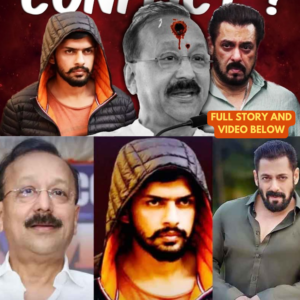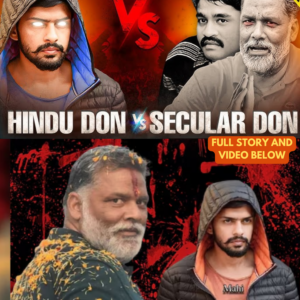How Lawrence Bishnoi Plans To Became No.1 Criminal Of India & A ‘Hindu’ Don | Akash Banerjee & Rishi
In recent years, India has witnessed a troubling evolution in its criminal landscape, characterized by the rise of figures like Lawrence Bishnoi. With a reputation for high-profile crimes and a growing influence, Bishnoi represents a new breed of gangster whose impact extends beyond traditional crime. His notoriety has sparked intense debates about the changing values within society and the implications for law enforcement and governance.
Early Life and Background
Lawrence Bishnoi was born in February 1993 in a well-off family in Punjab. His father, a former police constable turned farmer, owned substantial land, providing Lawrence with a comfortable upbringing. Despite his privileged background, he sought excitement and validation beyond academics. This desire for recognition would later lead him down a dark path. Lawrence’s early years were marked by a mix of privilege and ambition, creating a foundation for his future pursuits in both politics and crime.
Involvement in Student Politics
Bishnoi’s foray into crime began during his college years at Punjab University, where he became heavily involved in student politics. His charisma and strong personality helped him establish a following, but this also attracted rivalries. As he became embroiled in the competitive and often violent world of campus politics, his frustration grew, leading him to resort to intimidation and violence. This transition from political ambition to criminal behavior was swift and marked a significant turning point in his life.
Formation of the Bishnoi Gang
Following setbacks in his political ambitions, Bishnoi began forming alliances with other students who shared his views and frustrations. Together, they founded the Bishnoi gang, which quickly gained notoriety for its ruthless tactics. Engaging in extortion, arms smuggling, and targeted attacks, the gang swiftly established a reputation for violence. The camaraderie among gang members was built on shared experiences of betrayal and a desire for power, creating a tight-knit organization that operated with little fear of consequences.
High-Profile Crimes
One of the most shocking incidents associated with Bishnoi is the murder of Punjabi singer Sidhu Moose Wala in May 2022. This high-profile crime not only amplified his notoriety but also demonstrated the gang’s reach and influence, raising serious questions about the efficacy of law enforcement in controlling such figures. The assassination sent shockwaves through the entertainment industry and the general public, highlighting the dangerous intersection of crime and celebrity culture in India. Moose Wala’s murder was not just a personal vendetta; it was a statement of power, signaling to rivals and followers alike that Bishnoi’s gang was a formidable force.
Operations from Behind Bars
Despite being incarcerated since 2014, Lawrence Bishnoi continues to orchestrate criminal activities from behind bars. Reports suggest he commands a network of over 700 shooters, employing advanced communication methods to maintain control over his operations. His ability to operate from prison underscores a significant flaw in the criminal justice system, raising alarming questions about the extent of his influence. It appears that his connections, both inside and outside prison walls, have enabled him to maintain a criminal empire, demonstrating the challenges faced by law enforcement agencies in curbing organized crime.
Media and Public Perception
The media plays a crucial role in shaping public perception of criminal figures like Bishnoi. His portrayal as a “Hindu Don” has resonated with certain segments of society, leading to a surprising fanbase that admires his audacity and power. This narrative, often glamorized, has complicated the moral implications of his actions. Social media platforms have further amplified his image, attracting a younger audience that views him as a modern-day Robin Hood, despite his involvement in heinous crimes. The romanticization of his persona raises concerns about the values being imparted to the youth, with many idolizing his lifestyle without acknowledging the violence and terror it entails.
Political Implications
The intersection of crime and politics is a critical issue in contemporary India. Speculation about Bishnoi’s potential political aspirations adds another layer of complexity to his story. Given his growing popularity, there are concerns that he could leverage his status to gain political power upon his release. This scenario poses a significant threat to democratic institutions, as the line between legitimate governance and criminal influence continues to blur. The political landscape could be dramatically altered if figures like Bishnoi are allowed to transition from crime to political power, raising fears about the erosion of law and order.
Societal Reflections
Bishnoi’s rise reflects broader societal issues, including the glorification of violence and the troubling romanticization of criminal figures. In a culture increasingly influenced by social media, young people are drawn to narratives that celebrate gangsters as heroes. This admiration for criminality signals a shift in values, where strength and intimidation are prioritized over integrity and hard work. As society grapples with these changes, the danger of idolizing figures like Bishnoi becomes increasingly apparent, posing challenges for future generations.
Conclusion
Lawrence Bishnoi’s story is a cautionary tale about the intersection of crime, politics, and societal values in India. His rise serves as a stark reminder of the complexities surrounding organized crime and its implications for governance and law enforcement. As India navigates this troubling landscape, it is crucial to address the underlying issues that allow figures like Bishnoi to thrive. Ensuring that the rule of law prevails over the allure of criminality is essential for maintaining social order and protecting democratic values. The story of Bishnoi is far from over, and the need for effective strategies to combat such influences is more pressing than ever.
News
Amitabh Bachchan behaved badly with his daughter-in-law Aishwarya Rai | Amitabh IGNORE Aishwarya Rai
In recent weeks, a wave of speculation has emerged suggesting that all may not be well between former Miss World Aishwarya Rai and the iconic Bachchan family. This speculation has captured the attention of fans and the media, as rumors…
Amitabh gave a message to daughter-in-law Aishwarya Rai, said “No matter how your house is, it is yours”
Amitabh Bachchan, the iconic figure of Indian cinema, has a longstanding tradition of engaging with his audience through social media. He often shares reflections on his life, career, and personal philosophies. Recently, a particular post of his has stirred significant…
Salman Khan vs Lawrence Bishnoi | Why it is Happening? |
Salman Khan vs Lawrence Bishnoi | Why it is Happening? | The tension between Bollywood superstar Salman Khan and gangster Lawrence Bishnoi has become a hot topic in recent news. This clash is not just a simple feud; it embodies…
Lawrence Bishnoi Vs Pappu Yadav | Bishnoi Targets Anti-India Mafia?
In the ever-evolving landscape of India’s criminal underworld, a new chapter is unfolding, marked by the dramatic confrontation between notorious gangster Lawrence Bishnoi and the infamous Bihar don, Pappu Yadav. This rivalry has escalated recently, with Bishnoi’s gang issuing a…
LAWRENCE BISHNOI VS SALMAN KHAN, PAKISTANI PUBLIC REACTION AFTER NADEEM KHAN VIRAL VIDEO, REAL TV
The recent controversy involving Bollywood superstar Salman Khan and Lawrence Bishnoi has sparked intense discussions across communities, especially concerning allegations of animal cruelty. The speaker, representing a particular community, emphasizes that if there is evidence that Khan has harmed a…
LAWRENCE BISHNOI’S DIWALI GIFT TO PAPU YADAV LIVE, AFTER NADEEM KHAN & SALMAN KHAN, LATEST NEWS
In a recent live discussion, significant attention was drawn to the ongoing tensions surrounding Pappu Yadav and Lawrence Bishnoi, especially in light of recent developments involving prominent figures like Nadeem Khan and Salman Khan. The speaker began by addressing the…
End of content
No more pages to load











